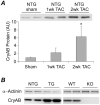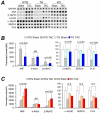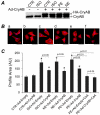Alpha B-crystallin suppresses pressure overload cardiac hypertrophy
- PMID: 18974385
- PMCID: PMC2610480
- DOI: 10.1161/CIRCRESAHA.108.180117
Alpha B-crystallin suppresses pressure overload cardiac hypertrophy
Abstract
AlphaB-crystallin (CryAB) is the most abundant small heat shock protein (HSP) constitutively expressed in cardiomyocytes. Gain- and loss-of-function studies demonstrated that CryAB can protect against myocardial ischemia/reperfusion injury. However, the role of CryAB or any HSPs in cardiac responses to mechanical overload is unknown. This study addresses this issue. Nontransgenic mice and mice with cardiomyocyte-restricted transgenic overexpression of CryAB or with germ-line ablation of the CryAB/HSPB2 genes were subjected to transverse aortic constriction or sham surgery. Two weeks later, cardiac responses were analyzed by fetal gene expression profiling, cardiac function analyses, and morphometry. Comparison among the 3 sham surgery groups reveals that CryAB overexpression is benign, whereas the knockout is detrimental to the heart as reflected by cardiac hypertrophy and malfunction at 10 weeks of age. Compared to nontransgenic mice, transgenic mouse hearts showed significantly reduced NFAT transactivation and attenuated cardiac hypertrophic responses to transverse aortic constriction but unchanged cardiac function, whereas NFAT transactivation was significantly increased in cardiac and skeletal muscle of the knockout mice at baseline, and they developed cardiac insufficiency at 2 weeks after transverse aortic constriction. CryAB overexpression in cultured neonatal rat cardiomyocytes significantly attenuated adrenergic stimulation-induced NFAT transactivation and hypertrophic growth. We conclude that CryAB suppresses cardiac hypertrophic responses likely through attenuating NFAT signaling and that CryAB and/or HSPB2 are essential for normal cardiac function.
Figures








Comment in
-
Rescuing cardiac malfunction: the roles of the chaperone-like small heat shock proteins.Circ Res. 2008 Dec 5;103(12):1351-3. doi: 10.1161/CIRCRESAHA.108.189720. Circ Res. 2008. PMID: 19059837 Free PMC article. Review. No abstract available.
Similar articles
-
Cross-talk between calcineurin/NFAT and Jak/STAT signalling induces cardioprotective alphaB-crystallin gene expression in response to hypertrophic stimuli.J Cell Mol Med. 2010 Jun;14(6B):1707-16. doi: 10.1111/j.1582-4934.2009.00804.x. Epub 2009 Jun 16. J Cell Mol Med. 2010. PMID: 19538478 Free PMC article.
-
Protein quality control in protection against systolic overload cardiomyopathy: the long term role of small heat shock proteins.Am J Transl Res. 2010 Jul 21;2(4):390-401. Am J Transl Res. 2010. PMID: 20733949 Free PMC article.
-
HSPB2 is dispensable for the cardiac hypertrophic response but reduces mitochondrial energetics following pressure overload in mice.PLoS One. 2012;7(8):e42118. doi: 10.1371/journal.pone.0042118. Epub 2012 Aug 1. PLoS One. 2012. PMID: 22870288 Free PMC article.
-
Desmin filaments and cardiac disease: establishing causality.J Card Fail. 2002 Dec;8(6 Suppl):S287-92. doi: 10.1054/jcaf.2002.129279. J Card Fail. 2002. PMID: 12555134 Review.
-
Molecular mechanisms of α-crystallinopathy and its therapeutic strategy.Biol Pharm Bull. 2011;34(11):1653-8. doi: 10.1248/bpb.34.1653. Biol Pharm Bull. 2011. PMID: 22040875 Review.
Cited by
-
Genetic Deletion of HLJ1 Does Not Affect Blood Coagulation in Mice.Int J Mol Sci. 2022 Feb 13;23(4):2064. doi: 10.3390/ijms23042064. Int J Mol Sci. 2022. PMID: 35216179 Free PMC article.
-
Progression of the role of CRYAB in signaling pathways and cancers.Onco Targets Ther. 2019 May 30;12:4129-4139. doi: 10.2147/OTT.S201799. eCollection 2019. Onco Targets Ther. 2019. PMID: 31239701 Free PMC article. Review.
-
Ubiquitin and Ubiquitin-like proteins in cardiac disease and protection.Curr Drug Targets. 2018;19(9):989-1002. doi: 10.2174/1389450117666151209114608. Curr Drug Targets. 2018. PMID: 26648080 Free PMC article. Review.
-
Hypertrophic Cardiomyopathy-Associated CRYABR123W Activates Calcineurin, Reduces Calcium Sequestration, and Alters the CRYAB Interactome and the Proteomic Response to Pathological Hypertrophy.Int J Mol Sci. 2025 Mar 7;26(6):2383. doi: 10.3390/ijms26062383. Int J Mol Sci. 2025. PMID: 40141027 Free PMC article.
-
The ubiquitin-proteasome system and cardiovascular disease.Prog Mol Biol Transl Sci. 2012;109:295-346. doi: 10.1016/B978-0-12-397863-9.00009-2. Prog Mol Biol Transl Sci. 2012. PMID: 22727426 Free PMC article. Review.
References
-
- Kumarapeli AR, Wang X. Genetic modification of the heart: chaperones and the cytoskeleton. J Mol Cell Cardiol. 2004;37:1097–1109. - PubMed
-
- Taylor RP, Benjamin IJ. Small heat shock proteins: a new classification scheme in mammals. J Mol Cell Cardiol. 2005;38:433–444. - PubMed
-
- Perng MD, Muchowski PJ, van Den IP, Wu GJ, Hutcheson AM, Clark JI, Quinlan RA. The cardiomyopathy and lens cataract mutation in alpha B-crystallin alters its protein structure, chaperone activity, and interaction with intermediate filaments in vitro. J Biol Chem. 1999;274:33235–33243. - PubMed
-
- Wang X, Robbins J. Heart failure and protein quality control. Circ Res. 2006;99:1315–1328. - PubMed
-
- Fan GC, Ren X, Qian J, Yuan Q, Nicolaou P, Wang Y, Jones WK, Chu G, Kranias EG. Novel cardioprotective role of a small heat-shock protein, Hsp20, against ischemia/reperfusion injury. Circulation. 2005;111:1792–1799. - PubMed
Publication types
MeSH terms
Substances
Grants and funding
LinkOut - more resources
Full Text Sources
Other Literature Sources
Molecular Biology Databases
Research Materials

